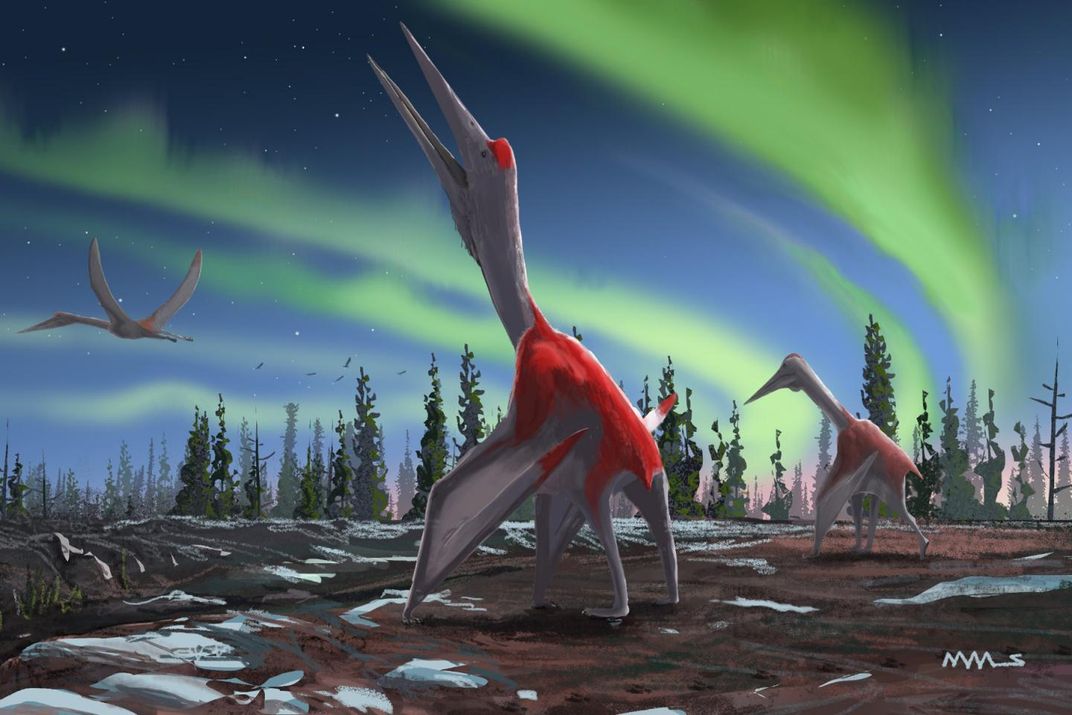Massive ‘Ice Dragon’ Ruled the Skies Above Ancient Alberta
The newly described pterosaur with a wingspan over 30-feet was one of the largest flying creatures to ever exist
/https://tf-cmsv2-smithsonianmag-media.s3.amazonaws.com/filer/a2/18/a2184a45-073f-48d2-9079-2eb240429b47/pterosaur_1.jpg)
Some 77 million years ago, you would have been wise to keep a wary eye on the skies above what is now Alberta, Canada. That's because one of the largest flying animals to ever exist called the province home.
The species, described in a new study, is actually not all that new. It was dug up in Dinosaur Provincial Park in 1992, and its skeletal remains were kept at the Royal Tyrrell Museum. Back then, however, paleontologists assumed it was a specimen of an azhdarchid pterosaur with a 32-foot wingspan called Quetzalcoatlus northropi. First dug up in Texas in 1972, Quetzalcoatlus was the largest flying animal to ever live.
Azhdarchid pterosaurs, however, are one of the most difficult ancient creatures to classify since the remains of their delicate bones are rare and fragmentary. Over the last 15 years, other species of azhdarchids have been unearthed in Europe and North Africa, allowing researchers to better understand the characteristics and differences within the group.
When researchers took another look at the 1992 fossil, they were better able to compare it to Quetzalcoatlus. In particular, they examined the neck vertebra, which contains pneumatophores, or holes where air sacs once were that are now used to identify pterosaur species. The neck holes showed that the specimen was different from all other azhdarchids, indicating it was a new flying giant. The creature, named Cryodrakon boreas in honor of the ice dragon in “Game of Thrones,” is described in the Journal of Vertebrate Paleontology.
As Michael Greshko at National Geographic reports, the specimen from the Royal Tyrrell had a wingspan of about 16 feet and was likely a juvenile, but another incomplete bone at the museum that is believed to be from the same species shows that it reached mammoth proportions, with a wingspan of more than 30 feet, 8-foot-tall shoulders when standing on ground and an estimated weight of 550 pounds.
Based on the fossils studied, Cryodraken appears to have had a long neck but not quite as long as the similarly huge Quetzalcoatlus, lead author David Hone, a paleontologist at Queen Mary University of London, tells the CBC. It likely lived in a tropical environment hunting mammals, lizards and small dinosaurs.

“Really as soon as I started looking in detail it was clear there were some differences between the two,” first author David Hone of Queen Mary University London tells Hannah Osborne at Newsweek. “I think a fair number of researchers have suspected as much for a while, but sitting down to do the work and getting into the details takes time."
Understanding how these massive beasts took to the skies has applications outside of paleontology. “This particular group of pterosaurs includes the largest flying animals of all time,” co-author Michael Habib of the University of Southern California says in the release. “Their anatomy holds important clues about the limits of animal flight and may be important in the future for biologically inspired mechanical design for flight.”
But that understanding is coming slowly, since so few well-preserved fossils of the animals have been found. “It’s an ongoing challenge for paleontologists to piece together how the ridiculously huge azhdarchid pterosaurs launched themselves into the sky and flew,” Armita Manafzadeh, doctoral candidate at Brown University, tells George Dvorsky at Gizmodo. “As we continue to learn more about the diversity of these critters and their body plans, we’re slowly gathering the information that we need to better understand how they moved over 70 million years ago.”
Habib says understanding these giant flying hunters is also crucial for getting a full understanding of how life evolved during the Cretaceous. “These are among the most popular and charismatic of all fossil animals,” he says in the release. “They have been inspiration for countless movie monsters, they were critical parts of global ecosystems worldwide during the Age of Dinosaurs, so they are key to understanding the ecology and extinctions of that time, and, just like flying animals today, they could carry important clues about how animals at the time responded to major changes in climate.”